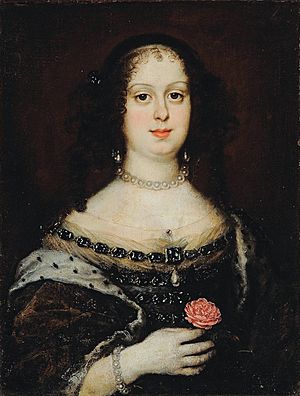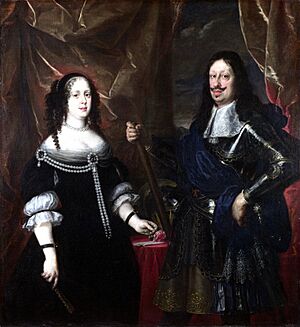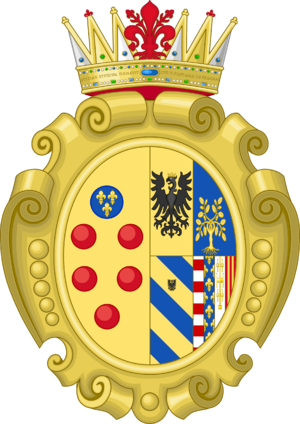Vittoria della Rovere facts for kids
Quick facts for kids Vittoria della Rovere |
|||||
|---|---|---|---|---|---|

Portrait by Justus Sustermans, c. 1640-1645
|
|||||
| Grand Duchess consort of Tuscany | |||||
| Tenure | 6 April 1637 – 23 May 1670 | ||||
| Born | 7 February 1622 Ducal Palace of Pesaro, Urbino |
||||
| Died | 5 March 1694 (aged 72) Ducal Palace of Pisa, Tuscany |
||||
| Spouse | Ferdinando II de' Medici | ||||
| Issue | Cosimo III, Grand Duke of Tuscany Francesco Maria, Duke of Rovere |
||||
|
|||||
| House | House of Medici House of della Rovere |
||||
| Father | Federico Ubaldo della Rovere | ||||
| Mother | Claudia de' Medici | ||||
Vittoria della Rovere (born February 7, 1622 – died March 5, 1694) was a powerful noblewoman. She became the Grand Duchess of Tuscany. This happened when she married Grand Duke Ferdinando II.
Vittoria and Ferdinando had four children. Two of them lived past infancy. These were Cosimo III, who became Tuscany's longest-ruling leader, and Francesco Maria, who became a high-ranking church official called a Cardinal.
When her grandfather, Francesco Maria della Rovere, passed away, Vittoria inherited the lands of Rovere and Montefeltro. These lands later went to her second son, Francesco Maria, after her death. Vittoria also helped raise her three grandchildren. Her marriage brought many valuable art pieces to the House of Medici. You can still see these treasures today in the Palazzo Pitti and the Uffizi Gallery in Florence.
Early Life and Inheritance
Vittoria della Rovere was the only child of Federico Ubaldo della Rovere. Her father was the son of the Duke of Urbino, Francesco Maria. Vittoria's mother was Claudia de' Medici. Claudia was the sister of Cosimo II de' Medici, Grand Duke of Tuscany.
When Vittoria was a baby, people expected her to inherit her grandfather's Duchy of Urbino. However, Pope Urban VIII convinced her grandfather to give the duchy to the Papal States. The duchy then became part of the Papal States. Instead, Vittoria received other family lands, the Duchies of Rovere and Montefeltro. She also inherited a large art collection. This became her property in 1631 when she was nine years old.
When Vittoria was just one year old, she was promised in marriage. She was to marry her cousin, Ferdinando II. He was the Grand Duke of Tuscany. Her mother, who was a Medici, sent Vittoria to Florence. There, she was raised at the Tuscan court.
The marriage was arranged by Ferdinando II's grandmother, Christina of Lorraine. Christina had been ruling Tuscany with her daughter-in-law, Maria Maddalena of Austria, since 1621. Even though Ferdinando II became old enough to rule on his own in 1628, Grand Duchess Christina remained very powerful. She held this power until she died in 1636.
Becoming Grand Duchess
Vittoria and Ferdinando secretly married on August 2, 1634. Their official public wedding took place on April 6, 1637. Vittoria was crowned Grand Duchess on July 5. Her inheritance, including the valuable art collections, became part of her dowry. A dowry is money or property a bride brings to her marriage. These art collections are now in the Uffizi and Palazzo Pitti. They became the property of the Grand Duchy of Tuscany.
Vittoria grew up in a convent called Crocetta. She received a very religious education. The Grand Duchesses who raised her had made Tuscany closely connected to the Papal States. Because of this upbringing, Vittoria was very religious. She often listened to priests in her later life. This sometimes annoyed her husband, who had more modern ideas.
More than six years after their wedding, Vittoria gave birth to a son. Sadly, he died when he was only two days old. Another son was born in 1640 but died at birth. Finally, in 1642, the couple had another son named Cosimo de' Medici. He was called the Grand Prince of Tuscany.
Vittoria made sure her children also received a very Roman Catholic education. This often caused arguments between her and the Grand Duke. They disagreed about how to educate their son, the Grand Prince.
After Cosimo's birth, Vittoria and Ferdinando grew apart. They briefly got back together in 1659. This led to the birth of their last child, Prince Francesco Maria, in 1660. Their marriage was not a happy one. They lived separately by agreement for many years.
Ferdinando II passed away in 1670. His son, the Grand Prince, then became Cosimo III. Cosimo III had married Marguerite Louise d'Orléans in 1661. She was a cousin of Louis XIV of France. They had a son, Prince Ferdinando, and a daughter, Princess Anna Maria Luisa. Weeks after Cosimo III became Grand Duke, Marguerite Louise was pregnant again.
Vittoria della Rovere and her daughter-in-law, Marguerite Louise, often competed for power. Vittoria had a lot of influence over her son, Cosimo III. Because of this, Vittoria usually won their disagreements. Cosimo III even gave his mother the job of managing Tuscany's daily affairs. Vittoria was officially allowed to join the Grand Duke's Consulta, or "Privy Council." This left Marguerite Louise feeling angry and ignored.
The two Grand Duchesses often argued about who was more important and about the Consulta. But Cosimo III always supported his mother. This made Marguerite Louise even angrier. By early 1671, the fighting between Marguerite Louise and Vittoria was so bad that people said the Pitti Palace was like "the devil's own abode." They said you could hear arguments all day long.
Vittoria hired Caterina Angiola Pieroncini as a lady-in-waiting. She sent Caterina to Paris in 1664 to learn needlework.
Vittoria was pleased when her daughter-in-law decided to leave for France in 1674. Marguerite Louise had been living almost like a prisoner at the Medici Villa in Poggio a Caiano. This was outside Florence. Eventually, the Grand Duke and Duchess decided to separate. Marguerite Louise agreed to stay at the Abbey Saint Pierre de Montmartre in Paris. She left Tuscany in 1675 and never returned.
Because Marguerite Louise left her children, Vittoria della Rovere became the guardian of her grandchildren. These were Grand Prince Ferdinando, Princess Anna Maria Luisa, and Prince Gian Gastone.
In her old age, Vittoria stopped being involved in politics. She spent long periods at the convent of the Montalve, also known as Villa La Quiete. She also stayed at the Villa del Poggio Imperiale. She moved some of the art she had inherited to this villa.
Vittoria della Rovere, the Grand Duchess of Tuscany, died in Pisa in 1694. She was seventy-two years old. She was buried at the Basilica of San Lorenzo, Florence. When she died, her son Francesco Maria, who had been a Cardinal since 1686, inherited the Rovere lands.
The titles of the Rovere family ended when the House of Medici line ended. This happened with the death of her grandson Gian Gastone de' Medici, Grand Duke of Tuscany in 1737. Her only granddaughter, Electress Palatine Anna Maria Luisa, left all the contents of the Medici properties to the Tuscan state in 1743. This agreement, called the Family Pact, made sure that Medici art and treasures stayed in Florence. This included the art Vittoria had inherited.
Children of Vittoria
Vittoria della Rovere and Ferdinando II de' Medici had the following children:
- Cosimo de' Medici, Grand Prince of Tuscany (born December 19, 1639 – died December 21, 1639). He died as a baby.
- A daughter who was not named (born 1640). She died at birth.
- Cosimo III de' Medici, Grand Duke of Tuscany (born August 14, 1642 – died October 31, 1723). He married Marguerite Louise d'Orléans and had children.
- Francesco Maria de' Medici (born November 12, 1660 – died February 3, 1711). He married Eleonora Luisa Gonzaga but had no children.
See also
 In Spanish: Victoria della Rovere para niños
In Spanish: Victoria della Rovere para niños
- Caterina Angiola Pieroncini, a lacemaker and lady-in-waiting for Vittoria della Rovere.



